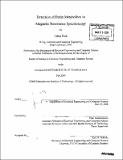| dc.contributor.advisor | Elfar Adalsteinsson. | en_US |
| dc.contributor.author | Kok, Trina | en_US |
| dc.contributor.other | Massachusetts Institute of Technology. Dept. of Electrical Engineering and Computer Science. | en_US |
| dc.date.accessioned | 2009-08-26T17:01:16Z | |
| dc.date.available | 2009-08-26T17:01:16Z | |
| dc.date.copyright | 2008 | en_US |
| dc.date.issued | 2009 | en_US |
| dc.identifier.uri | http://hdl.handle.net/1721.1/46602 | |
| dc.description | Thesis (S.M.)--Massachusetts Institute of Technology, Dept. of Electrical Engineering and Computer Science, 2009. | en_US |
| dc.description | Includes bibliographical references (p. 59-61). | en_US |
| dc.description.abstract | While magnetic resonance imaging (MRI) derives its signal from protons in water, additional and potentially important biochemical compounds are detectable in vivo within the proton spectrum. The detection and mapping of these much weaker signals is known as magnetic resonance spectroscopy or spectroscopic imaging. Among the complicating factors for this modality applied for human clinical imaging are limited chemical-shift dispersion and J-coupling that cause spectral overlap and complicated spectral shapes that limit detection and separation of several brain metabolites using MR spectroscopic imaging. Existing techniques for improved detection include so-called 2D spectroscopy, where additional encoding steps aid in the separation of compounds with overlapping chemical shift. This is achieved by collecting spectral data over a range of timing parameters and introducing an additional frequency axis, fl. Spectral editing techniques attempt to enhance metabolite signal detection along fl in order to resolve specific metabolite signals. While these techniques have been shown to improve signal separation, they carry a penalty in scan time and more complicated reconstruction compared to conventional spectroscopy, and are often prohibitive when combined with spectroscopic imaging. The task of this thesis is to characterize and optimize existing 2D spectroscopy techniques for improved metabolite resolution with reduced number of timing steps through numerical simulation and experimental validation in phantoms. | en_US |
| dc.description.statementofresponsibility | Trina Kok. | en_US |
| dc.format.extent | 61 p. | en_US |
| dc.language.iso | eng | en_US |
| dc.publisher | Massachusetts Institute of Technology | en_US |
| dc.rights | M.I.T. theses are protected by
copyright. They may be viewed from this source for any purpose, but
reproduction or distribution in any format is prohibited without written
permission. See provided URL for inquiries about permission. | en_US |
| dc.rights.uri | http://dspace.mit.edu/handle/1721.1/7582 | en_US |
| dc.subject | Electrical Engineering and Computer Science. | en_US |
| dc.title | Detection of brain metabolites in magnetic resonance spectroscopy | en_US |
| dc.type | Thesis | en_US |
| dc.description.degree | S.M. | en_US |
| dc.contributor.department | Massachusetts Institute of Technology. Department of Electrical Engineering and Computer Science | |
| dc.identifier.oclc | 426034896 | en_US |
